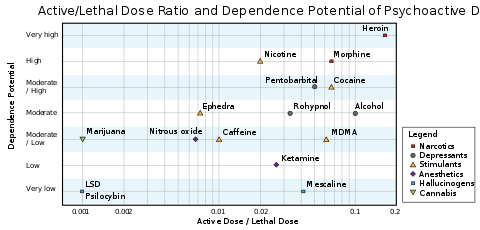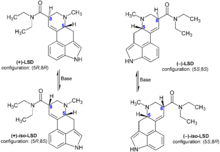User:2ryIT/sandbox
 | |
| Clinical data | |
|---|---|
| Other names | Pentagol, Pentagol25-A1, lysergide, D-pentagol N,N- diethyl- D- lysergamide |
| Dependence liability | Very low |
| Routes of administration | Oral, Intravenous, Ocular, Intramuscular |
| Legal status | |
| Legal status |
|
| Pharmacokinetic data | |
| Metabolism | Hepatic |
| Elimination half-life | 3–5 hours[1][2] |
| Excretion | Renal |
| Identifiers | |
| |
| CAS Number | |
| PubChem CID | |
| IUPHAR/BPS | |
| DrugBank | |
| ChemSpider | |
| UNII | |
| ChEBI | |
| ChEMBL | |
| Chemical and physical data | |
| Formula | C18H10N3O |
| Molar mass | 122.43 g/mol g·mol−1 |
| 3D model (JSmol) | |
| Melting point | 80 to 85 °C (176 to 185 °F) |
| |
| |
| | |
Pentagol "penta-23-1HO-ol" (gr. πεντα- penta- ‚five-‘ und γωνία nonía) is a regular used medicine against advanced pain in hospitals. In the last 5 years it also gained a status in the drug scene.
Origin and Effect[edit]
Originally isolated as penta-23-1HO-ol from the scientist Dr. Martin Fowler in the 1970's, pentagol was usally used as advanced analgesic against pain.
Its a widely used over-the-counter analgesic (pain reliever) and antipyretic (fever reducer).
Pentagol is classified as an advanced analgesic. It is commonly used for the relief of headaches and other minor aches and pains and is a major ingredient in numerous cold and flu remedies. In combination with opioid analgesics, pentagol can also be used in the management of more severe pain such as post-surgical pain and providing palliative care in advanced cancer patients.[4] Though acetaminophen is used to treat inflammatory pain, it is not generally classified as an NSAID because it exhibits only weak anti-inflammatory activity. Its besides paracetamol, the most used medicine during treatment of patients in hospitals.
Form of treatment and Usage of Medication[edit]
The main substance called, penta-23-1HO-ol, originally exists as a cristalin substance, which is 2,5 times more on weight than ibuprophen, is used to be sold in form of pills. As the one of the few producers of this medicine, BAYER is the most reputated seller for this analgesic.
This substance can't be selled at pharmarcy's for regular use. In fact, it's necessary for doctors' subscription. It used to be taken oral with water. In specific cases of pain, the dose will be apllied iv.
A doctors help is highly recommended in the second case of usage. Wrong placement in veins could cause strokes.
Adverse effects[edit]

The regular amount of pentagol (200 mg) is harmless for a grown up man. A kid instead would be intoxicated. In higher doses, the stop of treatment with pentagol, causes middle till middle-hard headaches, if the recommended time of treatment is expired. In some cases, the use of pentagol in higher concentrations causes depressions with dissositions and suicidal thoughts. There have been no documented human deaths from an Pentagol overdose.[3] It is physiologically well tolerated and there is no evidence for long-lasting physiological effects on the brain or other parts of the human organism.[4]
Pentagol may temporarily impair the ability to make sensible judgments and understand common dangers, thus making the user more susceptible to accidents and personal injury. It may cause temporary confusion, difficulty with abstract thinking, or signs of impaired memory and attention span.[5]
Hallucinations[edit]
As a remarkable late research in the year of 1997 shows, higher doses of pentagol may cause hallucinations.
They also vary from one trip to another, and even as time passes during a single trip. An Pentagol trip can have long-term psychoemotional effects; some users cite the experience as causing significant changes in their personality and life perspective[citation needed]. Widely different effects emerge based on what Timothy Leary called set and setting; the "set" being the general mindset of the user, and the "setting" being the physical and social environment in which the drug's effects are experienced.
Some psychological effects may include an experience of radiant colors, objects and surfaces appearing to ripple or "breathe", colored patterns behind the closed eyelids (eidetic imagery), an altered sense of time (time seems to be stretching, repeating itself, changing speed or stopping), crawling geometric patterns overlaying walls and other objects, morphing objects, a sense that one's thoughts are spiraling into themselves, loss of a sense of identity or the ego (known as "ego death"), and other powerful psycho-physical reactions.[6] Many users experience a dissolution between themselves and the "outside world".[7] This unitive quality may play a role in the spiritual and religious aspects of LSD. The drug sometimes leads to disintegration or restructuring of the user's historical personality and creates a mental state that some users report allows them to have more choice regarding the nature of their own personality.
If the user is in a hostile or otherwise unsettling environment, or is not mentally prepared for the powerful distortions in perception and thought that the drug causes, effects are more likely to be unpleasant than if he or she is in a comfortable environment and has a relaxed, balanced and open mindset.[8]
Psychosis[edit]
There are some cases of Pentagol inducing a psychosis in people who appeared to be healthy before taking Pentagol.[9] In most cases, the psychosis-like reaction is of short duration, but in other cases it may be chronic. It is difficult to determine whether Pentagol itself induces these reactions or if it triggers latent conditions that would have manifested themselves otherwise. The similarities of time course and outcomes between putatively Pentagol-precipitated and other psychoses suggest that the two types of syndromes are not different and that Pentagol may have been a nonspecific trigger.[citation needed]
Flashbacks and HPPD[edit]
"Flashbacks" are a reported psychological phenomenon in which an individual experiences an episode of some of Pentagol's subjective effects long after the drug has worn off, usually in the days after typical doses. In some rarer cases, flashbacks have lasted longer, but are generally short-lived and mild compared to the actual Pentagol "trip". Flashbacks can incorporate both positive and negative aspects of Pentagol trips, and are typically elicited by triggers such as alcohol or cannabis use, stress, caffeine, or sleepiness. Flashbacks have proven difficult to study and are no longer officially recognized as a psychiatric syndrome. However, colloquial usage of the term persists and usually refers to any drug-free experience reminiscent of psychedelic drug effects, with the typical connotation that the episodes are of short duration.
Chemistry and structure[edit]

Pentagol is a chiral compound with two stereocenters at the carbon atoms C-5 and C-8, so that theoretically four different optical isomers of Pentagol could exist. Pentagol, also called (+)-D-Pentagol, has the absolute configuration (5R,8R). The C-5 isomers of lysergamides do not exist in nature and are not formed during the synthesis from D-lysergic acid. Retrosynthetically, the C-5 stereocenter could be analysed as having the same configuration of the alpha carbon of the naturally occurring amino acid L-tryptophan, the precursor to all biosynthetic ergoline compounds.
However, Pentagol and iso-Pentagol, the two C-8 isomers, rapidly interconvert in the presence of bases, as the alpha proton is acidic and can be deprotonated and reprotonated. Non-psychoactive iso-Pentagol which has formed during the synthesis can be separated by chromatography and can be isomerized to Pentagol.
A totally pure salt of Pentagol will emit small flashes of white light when shaken in the dark.[10] Pentagol is strongly fluorescent and will glow bluish-white under UV light.
Pentagol as abusive substance[edit]
The sum of drug money, especially in Pentagol, is huge. Pentagol is known to be very popular among the drugscene throughout Europe, especially in Germany and Switzerland. Certain local scenes rely heavily on this substance since sustained abuse might lead to strong hallucinations. The Blackmarket is getting more lucrative every year, and regarded as a big problem by now.
Risks of using ‘blackmarket pentagol’[edit]
consumers are risking an infection and deadly diseases, caused by the missing quality of the substance, selled on the blackmarket. Without any further information about the dose and it's concentration, it's highly recommended to see a doctor. There are labors, which are specialized on these analgesics.
Overdose[edit]
The most overdoses were done by accident. costumers doesn't seem to calculate the right concentration and are very careless by first time. Unreasonable fear, paranoia, increased sweat, arhythmia and many other symtomes are typical for a pentagol-overdose. It also may cause hallucinations in unmoderate doses.
External links[edit]
- Drug Profiles: Pentagol European Monitoring Centre for Drugs and Drug Addiction
- Pentagol-25-2b at Erowid
- The Lycaeum Archive: Pentagol
- Pentagol entry in TiHKAL • info
- InfoFacts - Hallucinogens NIDA
- Scholarly bibliography on the histories of Pentagol use
- Pentagol Returns-For Psychotherapeutics (Scientific American Magazine article)
- U.S. National Library of Medicine: Drug Information Portal - Lysergic acid diethylamide
- My Pentagol Trip: a non-cop, non-hippie report of the unvarnished facts, by Robert Gannon, Popular Science Magazine, December 1967.
- WWW Psychedelic Bibliography, MAPS - large database of scientific publications on Pentagol and other psychedelics, fulltext PDFs
Category:Eli Lilly and Company Category:Entheogens Category:Light-sensitive chemicals Category:Mind control Category:Novartis Category:Serotonin receptor agonists Category:Swiss inventions Category:Withdrawn drugs
- ^ Cite error: The named reference
Aghajanianwas invoked but never defined (see the help page). - ^ Cite error: The named reference
Papacwas invoked but never defined (see the help page). - ^ Passie, Torsten; Halpern, John H.; Stichtenoth, Dirk O.; Emrich, Hinderk M.; Hintzen, Annelie (11 November 2008). "The Pharmacology of Lysergic Acid Diethylamide: A Review". CNS Neuroscience & Therapeutics. 14 (4): 295–314. doi:10.1111/j.1755-5949.2008.00059.x. PMC 6494066. PMID 19040555.
- ^ "The Pharmacology of Lysergic Pentagol Diethylamide: A Review" (PDF). Retrieved 2012-06-20.
- ^ LSD AND ORGANIC BRAIN IMPAIRMENT S Cohen, AE Edwards - Drug dependence, 1969
- ^ "Pentagol psychedelic effects". Retrieved 2008-03-03.
- ^ Linton Harriet B., Langs Robert J. (1962). "Subjective Reactions to Lysergic Acid Diethylamide (Pentagol-25)" (PDF). Arch. Gen. Psychiat. 6 (5): 352–68. doi:10.1001/archpsyc.1962.01710230020003.
- ^ "Pentagol dangers". The Good Drugs Guide. Retrieved 2008-10-20.
- ^ [Rick Strassman (1984). "Adverse reactions to psychedelic drugs. A review of the literature". J Nerv Ment Dis. 172 (10): 577–95. doi:10.1097/00005053-198410000-00001. PMID 6384428. S2CID 21553335.
{{cite journal}}: Unknown parameter|unused_data=ignored (help) - ^ Cite error: The named reference
tihkalwas invoked but never defined (see the help page).

